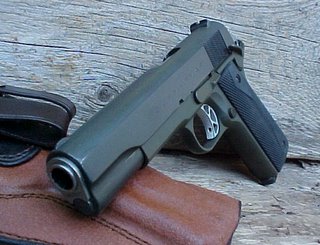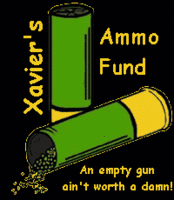Carry 1911s
Hello, I seem to lack the cunning to find your email address to ask a question that has been percolating in the back of my mind for a while. As you have moderation enabled, I beg your indulgence in abusing that detail as an ad hoc email. A while back you outlined what would constitute required elements, moderate features, and unacceptable bits for a carry 1911. Unfortunately, I am nowhere near as familiar with 1911s as you are and I wanted to ask you why you found things like a full-length guide rod undesirable. What are the pros and cons of the options you find significant? I've dug through your archive, but I was unsuccessful in finding a post where you answered those questions. Thank you for your time, and I look forward to further reading of your blog.I do not like the full length guide rod because it makes the pistol more difficult to field strip.
 It also prevents the user from pressing the front underside of the slide against a surface to clear a malfunction one handed. Some of my 1911s have a full length guide rod. The item works well enough, I see no reason to throw it towards the berm at Gunsite, but I also see no reason to buy one to put in a gun. The two piece Springfield full length guide rod is another story. I would Loc-Tite it or get rid of it.
It also prevents the user from pressing the front underside of the slide against a surface to clear a malfunction one handed. Some of my 1911s have a full length guide rod. The item works well enough, I see no reason to throw it towards the berm at Gunsite, but I also see no reason to buy one to put in a gun. The two piece Springfield full length guide rod is another story. I would Loc-Tite it or get rid of it. Most of the options/modifications I like in a carry 1911 are personal preference. They are: Fixed sights, flat mainspring housing, long trigger, Ed Brown grip safety. extended single sided thumb safety, durable finish, rubber grips, and a smooth front strap. Not all my 1911s fit this description, nor do all my carry 1911s. I feel it's more a matter of the fellow who totes the gun, his willingness to defend himself, and the tactics he uses that will persevere in a lethal encounter. The number of lines per inch of the checkering on the frontstrap of his 1911 has little to do with it.
The one common criteria I demand in any carry gun is 100% reliability. I expect it to be able to fire 500 consecutive trouble free rounds of all types of ammunition.
Ah Hell.....I found the original post for you, I think......
Labels: 1911's








8 Comments:
X,
I took your advice and bought a Model 10 has my first gun. I love it and would like to buy a 1911. What would you recommend as a first 1911. I will be buying used, and will use it to become proficient in firing a 1911. Thanks for our help and great blog.
T.
Expand your horizons
I started reading your excellent blog right after I bought my first (and planned to be my LAST) center fire pistol. It’s a 9mm polymer. I like it fine. It is barely broken in. But thanks to you Xavier, I find I have a strange compulsion to go out and buy a 1911 in .45 caliber. The ammunition will cost TWICE as much. I fall asleep thinking about it.
I’d like to return the favor. The final (and some say finest) example of John Moses Browning’s creative genius was the High-Power pistol. His elegant design eliminated the barrel bushing and rotating link, and was the first double-stack high-capacity handgun. It is the template for most pistols made today. It is single action for accuracy, and is made by FN with the craftsmanship of your beloved S&W wheelies. I’ve seen them with bluing so deep you can wade in it. Since you already have more 1911s than you can shoot, this is perfect for your next acquisition.
But don’t stop there. Browning patented about 100 guns, including many classics like the Colt Woodsman (which you have), Winchester 1894 and the first semiautomatic shotgun. His .50 caliber machine gun is widely used by the US military to this day. He even invented a 37mm anti-aircraft gun!
I hate to see you limit yourself Xavier. Think of the possibilities! Like I said, I’m just returning the favor. :)
P.S. For a great biography get American Gunmaker, by his son John Browning and Curt Gentry, published by Doubleday, 1964. It is fun to read, with many personal stories and a detailed listing of his creations. It’s available at Amazon.com.
T,
As a first 1911, I recommend a durable, reliable, basic model. For durability I require a forged, not cast frame and slide. For reliability, I recommend a Government (5 inch) Model.
Presently, there are several that fit that bill on the market.
The least expensive is the Springfield GI45. It's basic, forged, and pretty much to spec. A good solid gun. It requires a bit of lead down range to smooth out, and a bushing change may help accuracy, but it's a solid deal.
Next up is the Springfield Mil-Spec. Same basic gun with inproved sights, larger ejection port, and a few other changes. A good, reliable buy.
Colt's NRM (new roll mark) Series 80 1991 is a great deal, and if you think you will move towards a colt, you may as well start with a Colt.
On the used market, if you want more whizbangs, a Series I Kimber or a SW1911 is a good buy. I wouldn't pay the new prices though, but the guns are worth it if you want one of the Buck Rogers ones.
Here are a couple of posts that may help.
Post 1
Post 2
So, T, Keep it basic, keep it forged, and keep it a government Model.
Travlin.....Those pesky BHP....that's a bridge I won't cross. I shot a few of them, fondled a few of them, but they just don't speak to me very well. It's like they communicate in french or something, and I just don't get it. Now the 50 cals, oh yeah baby!......I remember firing those off the USS Midway. That's a gun!
Posting a question on this post rather than the original:
What is "dehorning?"
Dehorning=Smoothing out all corners, making the pistol more comfortable for carry. It's a bit less radical than "melting" a gun.
I really appreciate these posts. Learning about what does and doesn't work for someone along with why has widened my own awareness about what to look for in a firearm. I don't carry a 1911, but semi-autos have features in common and your posts have aided me greatly in finding what works for me.
X,
Thank you for all of the great information on the 1911's.
The link below is from Colt's website. It this the 1991 you where referring to? If so, is it a NRM, and what does new roll mark mean?
Again, Thank you.
T.
http://www.coltsmfg.com/cmci/1991.asp
It is T. At one time it had a large "billboard M1991A1 rollmark, known as the old roll mark, or ORM. It came in pakerizing with rubber grips then.
Post a Comment
<< Home